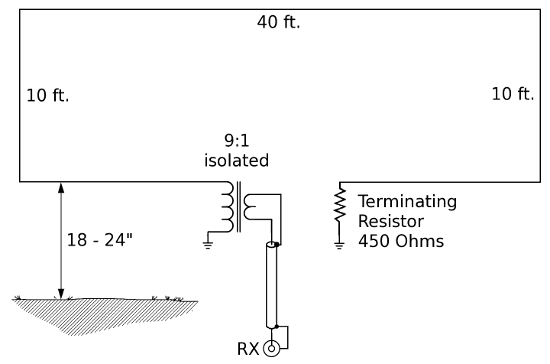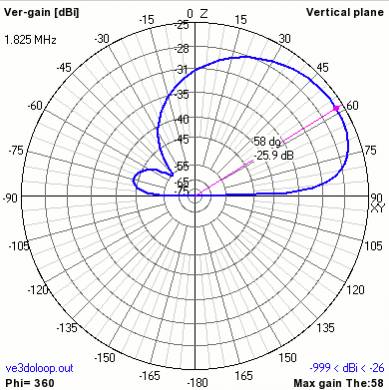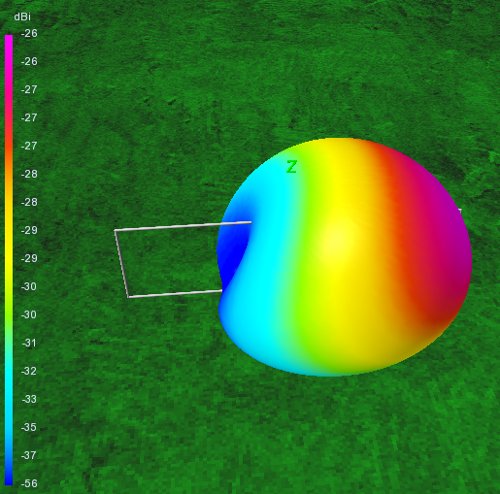| Меню сайта |
|
|
 |
|
Приемная антенна VE3DO
The first look recalls the K9AY diamond receiving loop, just in another (rectangular) shape. The antenna fires in the direction toward the matching transformer (opposite to a Beverage and the same as the K9AY Loop). The first installation at VE3CSK has the bottom wire 18" above ground which is moist clay loam.
The transformer uses a BN73-202 binocular core wound with 5 turns secondary winding and 2 turns primary winding. The secondary of the transformer connects between one side of the bottom horizontal wire and ground while the terminating resistor connects between the other side of the bottom horiz ontal wire and ground. The shield of the coax (which is 75 ohms for the turns ratio noted above) is NOT connected to the common ground of the transformer and resistor.
This ground isolation contributes to the very low-noise characteristics of the antenna. The coax was buried to within a foot of connection to the transformer. The same relay box as in the K9AY is used to switch the positions of the transformer HI winding and termination resistor, thereby switching the direction from which the antenna receives.
 The VE3DO loop The VE3DO loopInitial results (VE3CSK) have been very favourable; the comparison antennas at the summer home have been a "boomerang" beverage and a 550 ft standard Beverage. The loop is quieter than either but requires about 20 dB of preamplification to raise the signal level to that of the Beverages. On many mornings when the Beverages are too noisy for comfortable copy the loop is often able to provide fully copyable signals. This is not to say that one should remove the Beverages and receive only with terminated loops, because there is evidence to suggest that the loop responds to signals arriving at a higher angle than do Beverages. This means that the loop will be inferior to a 1 wavelength Beverage at least some of the time, at least equal to the Beverages some of the time, and better than the Beverages some of the time. K8GG has done an EZNEC analysis of the antenna with some interesting findings. First of all, he found that the most effective height above ground for the bottom horizontal wire is 8-12" and that the best terminating resistance is 510 ohms on 160 m. With these values and the wires installed taut as per the diagram, he obtained the following:
- Gain is -26dBi (a 1 wavelength Beverage has a gain of about -8 dBi or less, so a preamp is required for this loop antenna)
- Front-to-back ratio is approximately 20 dB
- Side lobes are down only about 4-5 dB
- Front lobe is approximately 150 degrees between the 3 dB points on 160 meters
- TOA (angle at which the antenna receives optimally) is 33 degrees, somewhat higher than that of a Beverage, nominally 10-20 degrees, but response is good down to about 10 degrees with less gain.
There is some evidence from both K8GG and W0OU to suggest that, while a ground is required (thus making the antenna "ground-dependent"), an extensive grounding system is not required, and a single ground rod of from 4-8 ft is sufficient. Lowering the bottom wire to a position 6" above ground level resulted in increased directivity. The comparison RX antennas are several 1000 ft Beverages and a standard pennant oriented 320 degrees; the soil is moist to wet clay loam. Results with this loop have been similar; on many days when the Beverages can hear virtually nothing because of high noise the loop often provides a copyable signal. My analysis confirms the results made by K8GG.  The vertical radiation pattern of the VE3DO loop The vertical radiation pattern of the VE3DO loop The horizontal radiation pattern of the VE3DO loop The horizontal radiation pattern of the VE3DO loop The 3D radiation pattern of the VE3DO loop The 3D radiation pattern of the VE3DO loop
First tests confirmed the almost identical properties like K9AY loop, there is no noticeable difference. A preamplifier of 18-20 dB gain with input filtering is a must. I highly recommend an input bandpass filter covering the 1.7 to 4 MHz range, the absolute minimum is an AM MW bandstop rejecting the strongest AM broadcast signal. The optimized terminating resistor was 486 Ohms (for best F/B, average soil). Like K9AY, this antenna is less sensitive to common mode current problems than an usual flag or pennant antenna. Anyway, the main disadvantage is the need of two supports, the VE3DO loop is sensitive to the soil properties and it can't be rotated. Anyway, there is no magic, and, at least here, the K9AY loop with its single support, seems more practical.
 |
| Категория: Антенны | Добавил: UY0LL (14.09.2009)
|
| Просмотров: 9911
| Рейтинг: 0.0/0 |
Добавлять комментарии могут только зарегистрированные пользователи. [ Регистрация | Вход ] |
|
| Вход на сайт |
|
|
 |
| Статистика |


Онлайн всего: 5 Гостей: 5 Пользователей: 0 |
Посетители сегодня:
UR7UD |
 |
|





 Приветствую Вас Гость
PDA|
Приветствую Вас Гость
PDA| 






 Приветствую Вас Гость
PDA|
Приветствую Вас Гость
PDA| 




